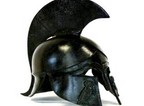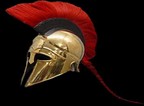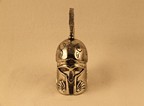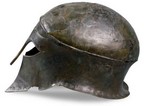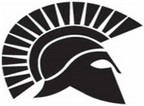There are many different Ancient Greek helmets that were used by different Greek kingdoms and cities. The helmets are some of the most recognized in historic war machines. However, the term Greek helmet is broad. This is mainly because Greek culture is not symbolized mainly by one particular set of helmet. Some of the helmets include Spartan helmet, Corinthian helmets, Chalcidicum helmets, attic helmets, Cretan helmets, Phrygian helmets, Chalcidicum helmets and Illyrian helmets as well as the hat like helmet. There are many designs that you will find in Greek stores however they are similar in one way or the other. The main difference comes in the color and plume. For example a Trojan helmet is available in silver, brass, black and bronze. There are instances where they come in camouflaging war paint colors. Most of the plumes come in colors of black, orange or red.
Understanding the Ancient Greek helmet types is very important in understanding the cities which were ruled. This is because different Greek kingdoms had different helmets which were clearly distinct from each other. Black and bronze colors were the most common in all Ancient Greek helmets. This was combined with red or black plume to finish it all up nicely. Spartan helmets are still very popular and they come from two main designs:
There is the silver plain which is made of steel or iron helmet with no plume. This was commonly worn by a foot Spartan soldier who burnt in the fighting. Some of Spartan elite soldiers or even leaders wore red plume helmets which retained a similar design as that of the foot soldier only that it had a large plume that had a tail end. This was mainly to the height of the soldier adding intimidation factor.
Corinthian helmets had a similar design to the Spartan helmets as far as the face was concerned. The only difference came in the cheek guards which were slightly longer than those of Spartan helmets. Consequently, Ancient Greek helmets are made of black metal or brass with a plume made of horse hair mostly. The replicas existing today are made of synthetic hair and in some cases very expensive horse hair.
Ancient Greek helmet types like the Illyrian helmet date back to the period from 550 BC to 450 BC. The helmets are well formed and heavy. They have open face with pronounced cheek flaps, neck flap and high dome. There are two double ridges that run along sagittal plane of the Illyrian helmet. The ridges are just above orbital area and the whole perimeter of the helmet is adorned with 150 bronze rivets.
The naming of this helmet type as the Illyrian helmet is owed to its original place it was manufactured basically in and also around regions of ancient Illyria. This was located in western Balkan Peninsula. They were primarily adopted by Greeks and thereby becoming their own primary helmet type and it was used throughout the 5th century.
The term Ancient Greek helmet types basically describes many different styles of helmets developed during the period between 8th and 7th centuries and were largely worn by soldiers in the Mediterranean for hundreds of years. When you talk about Ancient Greek helmets it covers the main helmet styles like the Illyrian, Corinthian, chalcidian, pilos, and Cretan, attic and phygian helmets.
The general idea in these Ancient Greek helmets is to help protect the head during war, the nose as well as cheek bones. All these helmets were mainly made of bronze. However, the Corinthian, Thracian, and chalcidian helmets were mainly crafted out of two pieces of metals. On the other hand, Ancient Greek helmet styles like Illyrian style helmets were made from solid metal piece.
How the Ancient Greek helmets were worn:
These Ancient Greek helmets in times of war were pulled down over a soldier’s face for protection. It protected the soldiers from arrows from enemy lines as well as swords during close one on one combat situation. The person wearing the helmet will slide the helmet back on their head even when not at war.
How Ancient Greek helmet types evolved:
Corinthian helmets are generally accepted by scholars as the first helmet design of the Greeks. This is a finding based on evidence of archeology. The helmet is thought to have limited vision of the wearer from the large portion of metal that covered one’s face. However overtime the design that gained advantage or very popular in battle is the one that is gives more visual access in battle.
The Ancient Greek helmets like those of pilus and Thracians were the less restrictive in battle. The helmets were easy and cheap to produce because they needed less facial protection and also they were not very detailed requiring less bronze to make. Cretan helmet designs were very unique in designs too. There were largely used in 7th century and 8th century.
On the other hand attic helmet designs made at the end of 4th century and first half of 2nd century BC. They are of Greek origin and the models were very popular in both Macedonia and Greece. In addition, they also became popular in Carthaginian army and the Thracian army too. It has also been determined from archeology that they were used in southern Italy. However, the exuberant models were in central Italy adorned with bronze decorative wings and feathers.
Romans borrowed the designs during their several campaigns in Greece in the 2nd century BC. The models became more popular among officers and later became one of the symbols of roman evolution. It is represented by frescoes and lapidary on both sides with variant fixed crest. There are models that are richly decorated and covered with silver leaf.
When visiting Greece you have a great opportunity to see live these great helmets which symbolizes Greek culture and traditions. They are available in archeological museums in various places in Greece and especially Athens. Moreover, you can buy one of the helmets being sold in shops to have something to cling on to as a sure testimony of your adventure in Greece.
